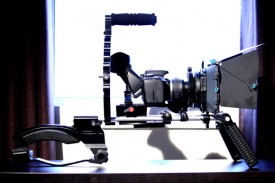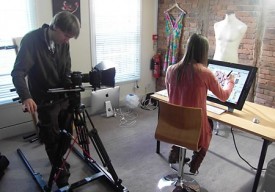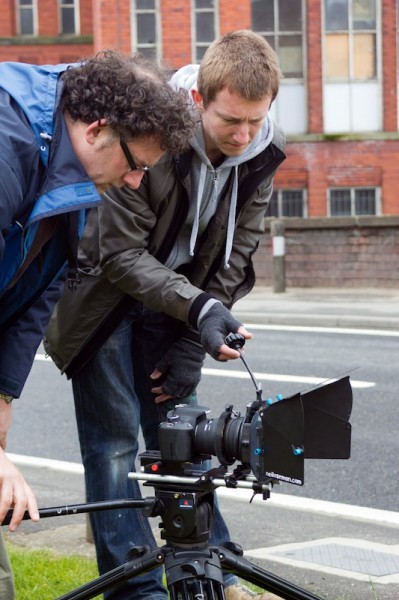Last July when I bought my Canon 600D (Rebel T3i) DSLR I also invested in a Proaim shoulder rig from Cine City. I reviewed the rig on this site soon afterwards, based mainly on playing about with it at home, but although I mentioned briefly how it fared during the Field Trip shoot last August I’ve never got around to giving a proper verdict on how this rig performs in a shoot scenario. Until now.
First and foremost, the rig is designed to give you the kind of smooth(ish) handheld shots you would get from a shoulder-mounted camera – broadcast/ENG, 16mm or whatever. While it certainly does that, all the weight of your DSLR is on the front of the rig, so it very quickly becomes difficult to hold up. You need to add a counterweight to the back – mine being a backpack which I can fill with whatever heavy stuff is to hand, loosely fastening the waist strap to prevent it swinging around. I’ve yet to make any serious use of this set-up, so I’ll have to get back to you on how it works out in the field.

Aside from the shoulder pad, the Proaim rig comprises several other elements which can be fitted onto the core rail system as required. These are:
- a two-stage matte box and sunshade
- follow focus
- hand grips
- a top handle (an optional extra I went for) with microphone mount
Prior to Stop/Eject, I generally fitted everything bar the follow focus whenever I used the camera. (Sadly most jobs I do lack the budget for a focus puller, and I don’t find the follow focus useful when pulling by eye.) To be perfectly honest, I did this mainly to make the camera look bigger and more impressive – particularly important on corporate jobs!

On Stop/Eject there was no time to have unnecessary accessories getting in our way, so I fitted only the follow focus, adding the matte box and sunshades very occasionally to flag a bit of backlight or use a graduated ND filter. Whenever I had to pick the camera up while still on the tripod, I regretted not fitting the top handle, but I never found time to put it on.
So the follow focus was the main part of the rig to get used. And I’m afraid the verdict here is not good. I knew before I bought the rig that many reviewers had complained about the gears having a little play in them. But I also knew that better quality follow focus units were out of my price range, and that some reviewers reported being able to reduce or remove the play by tightening a screw.

Well, no amount of screw tightening has done the job; there is still play. You can turn the focus knob about a millimetre before the focus ring of the lens starts to rotate. Shooting at f1.8 on my 20mm Sigma lens for a big wide – such as the master shot of the basement – that single millimetre can represent 20 metres of focal distance. Result? I had to pull the focus on that master shot by eye.
Col got skilled enough by the end of the shoot to compensate for this play, but it still caused us problems from time to time. I believe Cine City have now released a version two of their follow focus, so perhaps this is an improvement.
I have to say that the most effective parts of the rig are the matte box and sunshades. Aside from looking impressive, the ease with which you can flag off stray light is brilliant – no more gaffer-taping bits of cardboard to your camera.
But I was surprised to find on Stop/Eject that I was often bypassing the rig altogether and slapping the camera straight on the tripod.
You’ve got to do whatever’s going to get the job done right. I’d definitely advise having this rig in your arsenal, assuming you can’t afford one of the better quality options. With a decent counterweight it will massively improve your handheld shots, and the rest of the bits will come in handy too – just don’t expect to use all of them all of the time.
